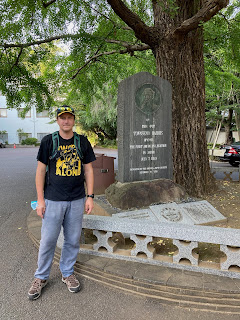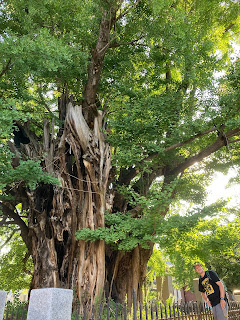It is hot, again. The first order of business is to get our 4th Lego figurine. Teens stay at home while parents go shopping at the Shinjuku Newday. We then take a walk in the Shinjuku-Wased area, looking for shade whenever possible. Slowly, we make our way to the Yayoi Kusama Museum. It’s lunchtime, and it is Unagi day, but there are no restaurants close-by. Thankfully, the corner Family Mart has nice looking Unagi Bentos for the occasion, so we buy some. In the process of paying the 4 bentos and 4 drinks, we receive a long ticket of special offers. The manager is nice enough to explain that we can exchange those tickets for 4 free drinks, which we do, this being a very hot day. We have spotted a little park not far, we eat in the shade. Very good, Happy Unagi Day!
We then move back to the museum The 5-story-high white and glass building is enjoyable looking, and you know directly you are at the right place thanks to the spots that figure on the entrance bay window. The backpack goes in a locker, and we start exploring the small museum. Clearly, Yayoi Kusama is at a quite commercial stage of her career, but it is interesting to read about her earlier works and to see a number of them. In any case, it is playful art. There is now pumpkin here, but a room with spots reflecting black light. After a little rest in the museum entrance, which serves as the shop at the same time, we start walking to the Waseda subway station. Our next stop will be the oldest Ginkgo in Tokyo. After human-made artistic beauty, natural beauty!
We are now walking in the Minato neighborhood, and soon reach a cemetery-slash-shrine. We are in a place where Townsend Harris opened the first American Legation in Japan, in 1859. A stone to commemorate this is at the foot of what is already a nicely sized Ginkgo. But the star of the show is clearly in the middle of the cemetery, you cannot miss it! It is a magnificent and huge Ginkgo, the Ginkgo Tree at Zenpukuji Temple. What a nice tree. It has been partially burnt during the war but survived and grew more. The light is beautiful, but the cemetery layout does not allow taking a picture of the entire tree. But we can check it from different sides.
The Giant Gingko Tree at Zenpukuji temple is said to be the oldest tree in Tokyo. Although it is only 20 meters in height, which is nothing special for a ginkgo tree, it is almost 10 meters in circumference, which makes it a giant. The history of the Giant Ginkgo Tree is bound to the Zenpukuji Temple history. The temple was founded in 824 by Kobo Daishi, founder of the Shingon sect of Buddhism. In 1232, Saint Ryokai, the abbot of the temple, switched allegiance and became a follower of Shinran Shonin, the founder of the rival Jodo Shinshu sect. According to legend, one day, as Shinran Shonin was leaving the temple after teaching Saint Ryokai the tenets of his sect, he stamped his staff on the ground to demonstrate how followers of other sects faced spiritual annihilation unless they started reading their prayers according to his formula. As if touched by a source from above, Shinran Shonin’s staff suddenly began to sprout buds and sent out branches. Roots grew from the other end of his staff and sunk themselves into the soil, and in no time at all it had become a stately ginkgo tree. In recognition of its preternatural girth, the Japanese government designated the Giant Ginkgo Tree at Zenpukuji a Natural Monument in 1926. A translation of the plaque that the Japanese government placed teaches us that it is called “upside-down Ginkgo” because the roots are rising, and the branch tips are extending downward. It suffered considerable damage during the Great Tokyo Air Raid, but, thankfully, survived.
We then take a stroll in the direction of Takanawa Gateway station, a new, very modern station in a neighborhood that is clearly being built anew. From there we walk to Shinagawa station: we have collected two more Eki stamps, and two more Lego stamps. From there we take the JR train to Shimbashi station and take the Monorail across the Rainbow bridge to reach Odaiba Seaside Park. There is normally a lantern showing this evening, but Covid has rendered it less interesting: the lanterns are just placed on boats in the distance. Still, we can admire the small version of the Statue of Liberty, which was placed there during a France Japan event. We admire the lighting of the Rainbow bridge from the other side, and we are far from alone. The lights are green today, it is the weekend! We find the impressive Buren gates, take a stroll in the Symbol Promenade Park, admire the giant Gundam Statue (“Unicorn Gundam Statue”), then head back home for much-needed showers and a quite late dinner. Tomorrow we are off early for a trip!


















Leave a Reply